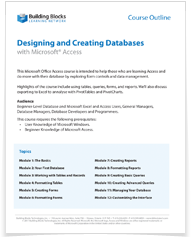Audience
Overview
Most organizations maintain and manage large amounts of information. One of the most efficient and powerful ways of managing data is by using relational database tools. Information can be stored, linked, and managed using a single relational database application and its associated tools. In this course, you will examine the basic database concepts, and create and modify databases and their associated objects using the Microsoft Office Access relational database application. In addition, you will also consider how to maintain data consistency, how to customize database components, and how to share Access data with other applications.
Topics
Section 1: Getting Started
- Starting Out
- Interface Basics
- Database Security
- Getting Help
Section 2: The New Interface
- The Quick Access Toolbar
- Basics of Tabs
- The Home Tab
- The Create Tab
- The External Data Tab
- The Database Tools Tab
Section 3: Creating a Database
- First Steps
- About Records
- Creating a Table
- Formatting Text
Section 4: Doing More with your Database
- Creating and Using Forms
- Creating and Using Queries
- Creating and Using Reports
- Sorting and Filtering Data
- Viewing Data
- Printing a Database Object
Skills Taught
- Understand the basic principles and fundamental concepts of Microsoft Office Access databases.
- Design and create tables in a new Microsoft Access 2010 Database.
- Enter data into Microsoft Access 2010 database tables.
- Filter table data and create criteria for basic queries to access, display, and sort the table data.
- Create basic entry forms for easier table input.
- Create basic paper-based reports for table/query output.
- Maintain database consistency and integrity through use of table properties, such as field settings, input masks, and validation methods.
- Design and utilize advanced multi-table queries, cross-tabulation queries and parameter queries and criteria.
- Customize Access data forms to provide for more flexible options for data input.
- Customize Access reports to better control and summarize data on table/query print-outs.
Unable to attend?
Please contact us to discuss alternative dates that work for you.
Can't see a date you previously saw?
Do not hesitate to contact us.
Course Outline


